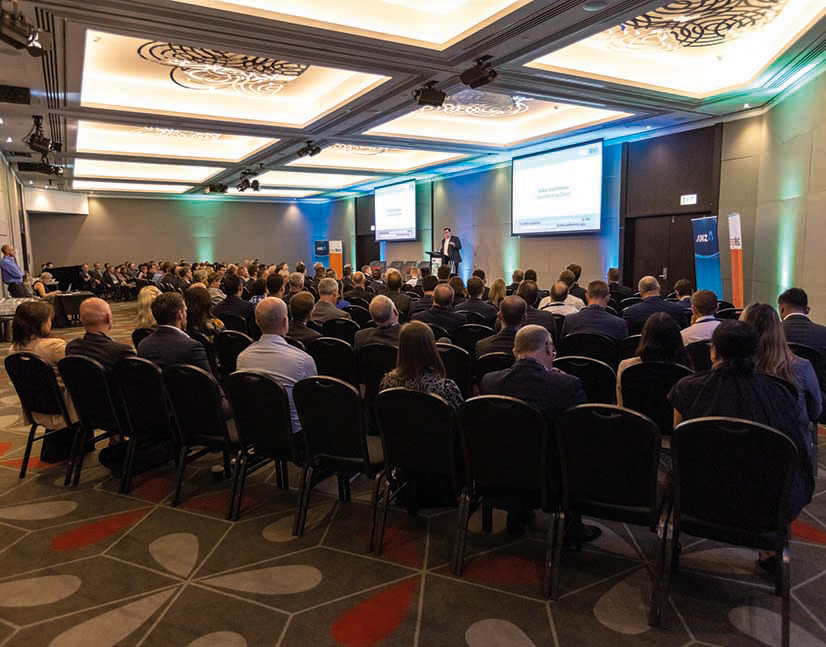
Leading the charge
One of the most significant aims of sustainable finance is developing climate-reporting standards that are as quantitative and robust as financial reporting. New Zealand is taking a global lead on mandatory climate reporting but there is much work to be done to reach the end goal.
Chris Rich Staff Writer KANGANEWS
The New Zealand government introduced the Financial Sector (Climate-related Disclosures and Other Matters) Amendment Bill into parliament in April 2021 – making it the first country to begin legislating a mandatory climate-related financial-disclosure regime. This regime will follow the Task Force on Climate-related Financial Disclosures (TCFD), created by the Financial Stability Board in 2015.
Now in its second reading, the bill is working its way through parliament (see box). Once passed, disclosures will be required for financial years beginning in 2022.
In 2017, TCFD produced recommendations outlining a framework for reporting climate-related financial information. TCFD recommendations are structured around four thematic areas that represent core elements of how organisations operate: governance, strategy, risk management and metrics, and targets. Under the themes, 11 disclosures are recommended.
The New Zealand government will make climate-related disclosures mandatory for around 200 organisations. These include listed companies with market capitalisation of more than NZ$60 million (US$42 million), the largest registered banks, licenced insurers and managers of investment schemes with more than NZ$1 billion in assets (see box).
Changes to New Zealand legislation
The New Zealand government will significnatly revise the Financial Sector (Climate-related Disclosures and Other Matters) Amendment Bill following the Economic Development, Science and Innovation Committee’s submissions process.
As part of the Task Force on Climate-related Financial Disclosures (TCFD) regime, elements of the disclosures relating to greenhouse-gas emissions will be required to have independent assurance. This aspect of the New Zealand rollout has caused consternation among reporting entities given the lack of breadth and depth in the local assurance industry.
Having been referred to the parliamentary Economic Development, Science and Innovation Committee for scrutiny as the bill progresses through parliament – and submissions heard – amendments will be made to allow an extra two years for the requirement that reporting entities arrange external assurance for their greenhouse-gas emissions. This means assurance will be required within three years of the bill passing.
Soon after the bill was introduced to parliament, New Zealand’s minister for climate change, James Shaw, warned that high-carbon investments will become increasingly risky as the government gets closer to meeting its climate targets. “We simply cannot get to net-zero carbon emissions by 2050 unless the financial sector knows what impact their investments are having on the climate. This law will bring climate risks and resilience into the heart of financial and business decision making,” he said.
In early 2021, the New Zealand Climate Change Commission (CCC) released its advice to the government on how to reshape the economy to meet the target of net-zero emissions by 2050. It sets out emissions budgets in three five-yearly plans out to 2035, giving the government until the end of year to detail its first emissions-reduction plan outlining the policies it will use to achieve the budgets.
If climate risks and resilience were not already at the heart of financial and business decision-making, the world was served an alarming update in early August. The UN Intergovernmental Panel on Climate Change (IPCC) released its sixth assessment report, once again bringing forward the time horizon to limit global warming to 1.5 degrees since industrialisation and thus further heightening the urgency of the response.
Having last warned the world could reach the tipping point by 2040, the latest report says the current emissions trajectory will trigger 1.5 degrees by 2030. Even under the most ambitious scenario, it estimates the world will reach 1.5 degrees by about 2035. Irreversible damage to ecosystems may already be underway, according to the IPCC.
Investor perspective
The Task Force on Climate-related Financial Disclosures framework is not just being applied to corporate entities in New Zealand. Among the other entities covered by forthcoming regulation are large asset managers. Some say they are already well prepared, as signatories to the UN Principles for Responsible Investment.
Investors arguably form the central point of the reporting nexus. Not only do they receive reporting from the targets of their investment – data on which they base allocation decisions – but they also have to produce reporting their own clients and regulators consider adequate.
Under New Zealand’s mandatory Task Force on Climate-related Financial Disclosures (TCFD) regime, all managers of registered investment schemes with more than NZ$1 billion (US$700.8 million) in total assets under management will be required to make climate-related financial disclosures.
CLIMATE STANDARD
To mandate a mitigation strategy, New Zealand reporting will be against one or more standards – and accompanying sector-specific guidance – to be developed by an External Reporting Board (XRB) in line with TCFD recommendations. The XRB is working on the standards and will deliver discussion documents in three iterations.
The XRB is an independent Crown entity responsible for accounting, auditing and assurance standards in New Zealand. In September 2020, when the New Zealand government announced its intention to implement mandatory reporting on climate risk, it tasked the XRB with developing reporting standards to support the new regime.
The XRB will release its first discussion document, covering governance and risk management, in October. The strategy-and-metrics and targets discussion paper will be released in March next year. The formal exposure draft will be released in July 2022 and will be open for a three-month consultation period.
April Mackenzie, Wellington-based chief executive at the XRB, tells KangaNews turning the TCFD recommendations – which are “voluntary, high-level principles” – into a mandatory regime with strict penalties presents a number of hurdles. “If we drop a standard onto entities from a great height it is bound to fail,” she says.
As such, the XRB is working with a wide range of stakeholders in an iterative and collaborative manner to develop the disclosures. “We need to take reporting entities on the journey with us and learn from them what is practical, because we acknowledge some of the systems associated with this information are not mature. It is not like accounting, which has been around for hundreds of years,” Mackenzie adds.
The overarching difficulty in reporting against the TCFD arises from its stated goal – to make it as rigorous and quantifiable as financial reporting. Financial reporting is quantitative and backward-looking, whereas reporting against the TCFD is largely qualitative and forward-looking.
Based on consultation with early implementers of TCFD and other stakeholders, Mackenzie suggests the lack of freely available New Zealand-specific climate data to inform scenario analysis is one of the prominent obstacles facing reporting entities.
Though reporting against the TCFD will not be as robust as financial reporting from the outset, Mackenzie says it will get there. “It has to be quantifiable and we will develop systems covering what good reporting looks like on the journey,” she says.
As a relatively small nation on the world stage, the XRB is working though how much of the recommendations should be adopted in New Zealand. Mackenzie says this is also manifesting itself into a question of what should be assigned to the standard and what should be designated to sector-specific guidance.
She explains: “While the standard will not be perfect on day one, we do not want to be changing it frequently either. We want to set mandatory parameters at a high level and then put quite a lot of the ‘how to’ in our guidance material. This will be very extensive, without overwhelming entities.”
In addition to the TCFD recommendations, the XRB is looking to the development of the International Sustainability Standards Board – currently being set up by the IFRS Foundation – for guidance.
But Mackenzie says transparency from the IFRS Foundation has so far been limited. “We had hoped to have learned more about how it was going to tackle materiality and narrowing greenhouse-gas options. This is not to rely on the IFRS Foundation to solve it for us, but to give us a sense of direction. However, the IFRS Foundation is playing its cards pretty close to its chest at the moment.”
SCENARIO ANALYSIS
As well as helping New Zealand meet its international obligations and achieve its net-zero emissions target, the goals of mandatory climate-related disclosures include ensuring the effects of climate change are routinely considered in business operations, helping climate-reporting entities better demonstrate responsibility and foresight in their consideration of climate issues and enabling a more efficient allocation of capital.
These goals are a significant reason why investors and other stakeholders value reporting against the TCFD. Though few New Zealand corporates are currently voluntarily reporting against it, Jorge Waayman, Wellington-based manager, ESG research at Harbour Asset Management, tells KangaNews one of the most useful developments thus far is the disclosure of scenario analysis and linking it to the financial impact of climate change.
“It is quite a challenging exercise to do but it makes the real-world impact a lot clearer from an investor’s point of view. Our clients want us to be able to align our portfolios with a 1.5 degree climate-change world. With this in mind, the better the information we receive, the more easily we are able to aggregate the data across our portfolios.”
A common bugbear when conducting ESG due diligence, however, is the limited and inconsistent reporting in the space. As the New Zealand Productivity Commission identifies in its Low Emissions Economy report, this information deficit drives “an ongoing and systemic overvaluation of emissions-intensive activities”.
One specific area of frustration is the assumptions underlying companies’ climate-change scenario analysis. Such analysis is the foundation of how entities present their TCFD report, fleshing out what risks need to be addressed and how a business is progressing in managing those risks. But the foundations of scenario analysis are currently the elephant in the room, according to Nicola Swan, Wellington-based partner at Chapman Tripp.
“Some climate scenarios are available but the challenge is to bring these down to a national level for New Zealand and then to a regional level for particular entities,” she says. “Without commonly accepted climate scenarios, it is very difficult for businesses to know where to start and to properly assess their risk. This is the data gap we have at the moment – reporting entities do not have the data for their scenario analysis.”
As a consequence, Waayman says it is difficult to define best practice for scenario analysis. “We do not currently place too much weight behind a company’s disclosure because there is just not a lot of data out there as things stand. Quite a small portion of the market is doing any TCFD reporting, let alone the scenario analysis part of it.”
Swan believes making high-quality benchmark scenarios or common assumptions available would significantly improve the quality of overall disclosures against the XRB’s new climate standard.
This is one of the areas the XRB is actively considering. The select-committee and submissions process reported on 16 August but this report included no clear guidance on whether the government should provide comprehensive standardised assumptions for the purposes of scenario analysis – despite many submissions calling for such an intervention.
Mackenzie says: “Prima facie, we would not expect it to be the XRB’s job to develop climate scenarios. But we may need to specify some pre-existing ones that can be used, or at least some climate variables to include in reporting entities’ scenarios.” She adds that government agencies as well as participants from specific sectors will have to collaborate to bring about common scenarios. “All XRB can do is raise the problem and try to figure out our role in the solution – and we have not yet figured this out.”
The potential to derive efficiency from consistent data is a sentiment echoed by Z Energy, even within the parameters of its own business. An early adopter of TCFD reporting – publishing its second report earlier in the year and now halfway through its four-year TCFD roadmap – Z Energy is one of three vertically integrated participants in New Zealand’s downstream fuel market. Its operations span crude-oil and refined-product procurement, contracted refining, national distribution, and commercial and retail marketing.
The energy sector is at the forefront of reporting against the TCFD in New Zealand. As physical risk poses a significant challenge in future for many in the sector, several entities have already voluntarily reported on climate issues for a number of years.
Nikita Chaudhari, Wellington-based transition lead at Z Energy, tells KangaNews the company is now integrating its scenario analysis across business operations. Before developing a house view in this area, Z Energy used Business Energy Council 2060 forecasts, IPCC projections and local New Zealand data, such as the NZ CCC advice for its scenario planning, to form two scenarios: rapid and slow transition.
Through the process of developing its TCFD roadmap, Chaudhari says scenario analysis and using the same base data have become an important foundation for the entire organisation and will enable it to make aligned decisions. “We are now ensuring the rapid- and slow-transition modelling is applied across the business.”
As important are the assumptions covering key risk areas that underlie scenario analysis, Lucie Drummond, Auckland-based general manager sustainability at Mercury, tells KangaNews. Mercury – which generates electricity from renewable sources and sells it through its retail brands – has reported annually against TCFD since 2018. It provides information on its governance and risk-management processes, and revealed its scenario analysis – including how this helps inform strategic disclosures – for the first time this year.
While Drummond says Mercury is growing in maturity in the area of scenario analysis, scarbon targets are currently the missing piece in the puzzle. Mercury’s TCFD report includes scope-one, scope-two and scope-three emissions. But it is dominated by scope-one – namely fugitive emissions from geothermal electricity generation. These account for 64 per cent of the entire profile.
Drummond says Mercury’s emissions intensity is consistent with a 1.5 degree future – as established by the Science-Based Target Initiative. But the company is working on meaningful carbon-reduction targets to bring down its emissions even more.
TRANSITION RISK
The XRB’s governance and risk-management discussion paper is eagerly anticipated, while its strategy-and-metrics and targets paper will provide information on the most significant aspects of TCFD reporting – namely, scenario analysis and the level of detail to be disclosed regarding scope-one, scope-two and scope-three emissions.
With little time between the release of the second discussion paper and the first reporting year, reporting organisations will have limited time to prepare.
This means it will be difficult for businesses to measure and plan for the physical risks that will materialise. Even so, Swan argues that capturing transition risk may be the more challenging task for TCFD reporting.
“Even if physical risk scenarios can be worked through, it is even more difficult to identify scenarios where consumer or market changes that will affect business are articulated. This is critical, because it is a market shift as a result of consumer concern regarding emissions that could drive a change to the products sold, or change the way they are sold.”
Swan cites the recent carbon-border adjustment mechanism the EU has signalled. “These regulatory changes are often hard to identify, not to mention the difficulty in quantifying the impact of them on a business. This is why actively identifying potential risks in advance is so important.”
Matt Hardwick, Z Energy’s Auckland-based corporate affairs manager, agrees. “We are really good at risk management – particularly physical risk – given the history of Z Energy being spun out of Shell and then buying Chevron’s New Zealand assets and business. What we have learned through the TCFD reporting process has been on the transition-risk side – on policy, markets and reputation. We will continue to learn about these in the future,” he says.
It is not just regulatory change that creates transition risk, but also the scenario analysis businesses rely on. The latest IPCC report undoubtedly heightened the urgency of this topic. But while the warnings contained within may have ramped up, New Zealand’s policymakers and business community will not have been unaware of the impending calamity if action is not taken to reduce emissions.
In May, the International Energy Agency released its roadmap for net-zero emissions by 2050, which contained more than 400 milestones. These include an expectation of no investment in new fossil-fuel supply projects and no further final investment decisions for new unabated coal plants. It also anticipates there will be no sales of new internal-combustion-engine passenger cars by 2035 and that the global electricity sector will reach net-zero emissions by 2040.
In its TCFD report, Mercury grades physical damage to its assets from extreme weather events as a “top five” risk. Drummond says it is highly unlikely Mercury will have to change its view on physical risk to its assets based on the latest IPCC report – because the company already has a conservative approach to risk-assessment.
“We build our assets, particularly our dams, to manage severe weather events. This means we need more detailed information than is provided in the national or international datasets from IPCC or, in New Zealand, published by the National Institute of Water and Atmospheric Research,” says Drummond.
She continues: “We are working with other organisations that have similar requirements to commission the data we need to deepen our understanding of longer-term physical risks over the course of the next year.”
Whatever the status of companies’ preparations, the updated guidance on a rapidly deteriorating climate increases the likelihood of regulation having to ratchet up if governments are to have any chance of meeting climate goals.
Drummond says the CCC’s work and advice to the government later this year will be the key guide to what regulation will be implemented and on what timeframe. She adds: “What governments do with the IPCC report at the COP26 summit in November will significantly influence transition risk and the pace of regulatory change.”
In early August, Z Energy released modelling for its house view on long-term liquid-fuel demand. This contained functionality to simulate future government policies, such as import bans on internal-combustion-engine vehicles, rebate schemes and biofuel mandates.
“Should decarbonising the transport sector happen more quickly because of changes in government policy, we stand ready for it and in some instances are in good shape to help accelerate changes – for instance with biofuels. We would be very supportive of a policy regime that seeks to accelerate the transition to a lower-carbon future,” Hardwick says.
Z Energy is now setting out to provide guidance on how to control for, mitigate or adapt to specific risks. “We deliberately talk about the response to climate-related risks in our annual report. A key component of the risk process that can be missed is the identification of opportunities. This is what the TCFD encourages,” Chaudhari explains.
The other significant risk that looms with TCFD reporting is for entities to see the mandatory regime through the lens of a compliance, box-ticking exercise.
However, as Swan explains the situation: “TCFD reporting allows entities to understand the risks and opportunities of climate change to their business, and to get ahead of where investor funds will flow as well as potential regulatory change. It will make businesses more resilient.”

WOMEN IN CAPITAL MARKETS Yearbook 2023
KangaNews's annual yearbook amplifying female voices in the Australian capital market.













